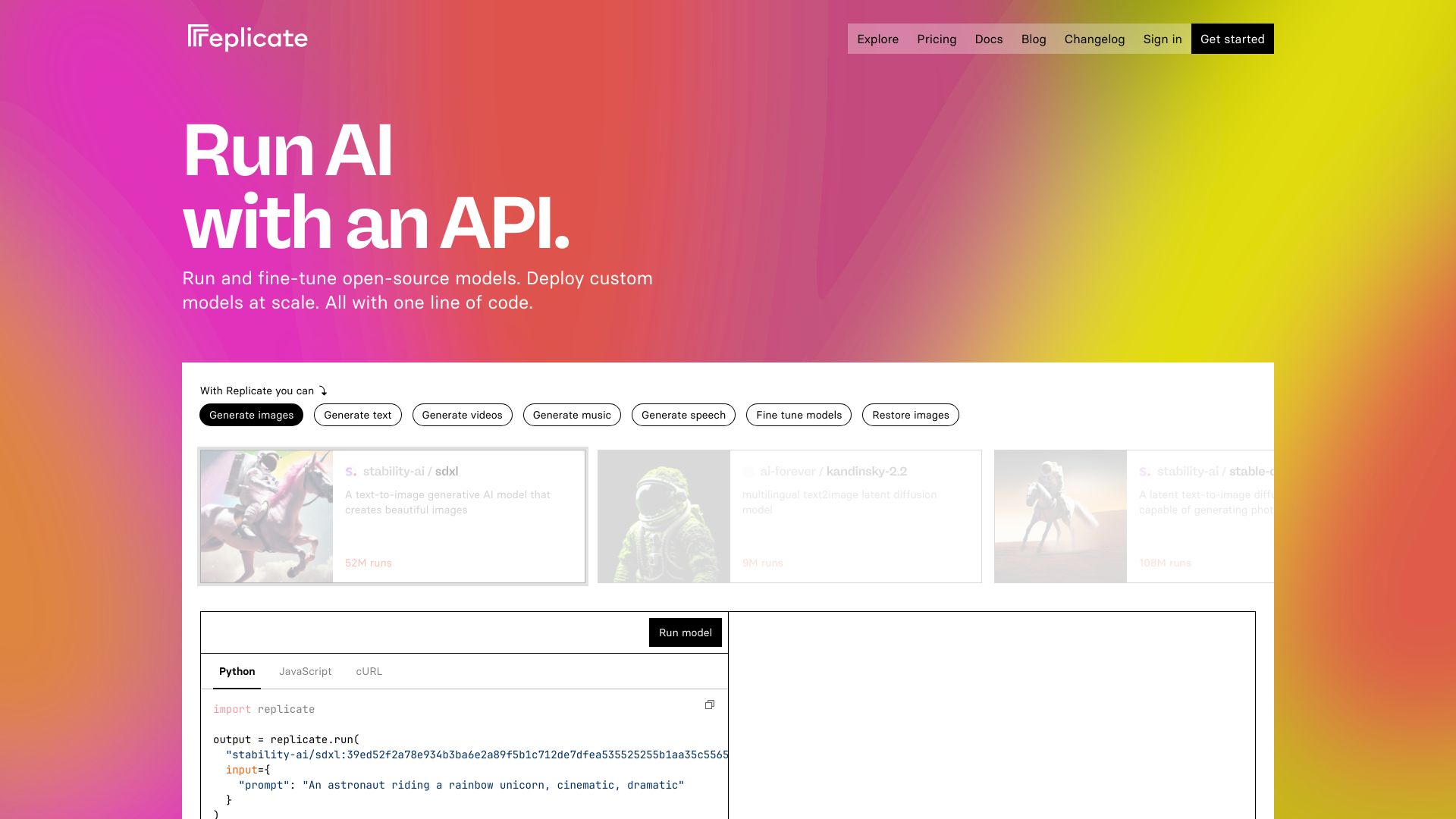- Home
- AI Text Generator
- Replicate

Replicate
Open Website-
Tool Introduction:AI friends on your Home Screen—unlimited chat, perfect memory.
-
Inclusion Date:Oct 21, 2025
-
Social Media & Email:
Tool Information
What is Replicate AI
Replicate AI is a cloud API platform for running open-source machine learning models in production. With a single line of code, developers can invoke, fine-tune, and deploy community models or their own custom models at scale, without managing GPUs or infrastructure. Replicate hosts thousands of models with versioned, production-ready endpoints for image generation, video generation, image restoration, captioning, speech and music generation, and text generation. It streamlines inference, training, and deployment via a clean HTTP API and clients, helping teams prototype quickly and ship reliable AI features.
Replicate AI Main Features
- Large model library: Access thousands of community-contributed, versioned models for image, video, audio, and text tasks.
- Production-ready APIs: Stable, versioned endpoints designed for scalable inference with minimal setup.
- Fine-tuning and training: Run training jobs and fine-tune supported models to fit domain data and targets.
- Custom deployments with Cog: Package your own model and deploy it to Replicate’s infrastructure for instant, scalable APIs.
- Autoscaling GPU inference: Handle spikes in traffic without managing hardware or orchestration.
- Async workflows: Use webhooks and job status polling to build resilient background processing pipelines.
- Streaming outputs: Stream tokens, progress logs, or partial results for supported models to improve UX.
- Python & JavaScript clients: Integrate quickly using official client libraries or raw HTTP requests.
- Model versioning and reproducibility: Pin exact versions to ensure consistent outputs across environments.
- Usage-based billing: Pay only for the compute you use, with clear metering and cost visibility.
Who Should Use Replicate AI
Replicate AI suits developers, startups, and product teams that need scalable inference without managing infrastructure. it's a strong fit for creative professionals (designers, marketers, video editors) who need fast access to image generation, video generation, and speech/music synthesis, as well as data scientists and researchers evaluating open-source models. Enterprises can integrate production-grade AI features into apps and workflows through a simple cloud API.
How to Use Replicate AI
- Create an account and obtain your API token from the dashboard.
- Browse the model catalog, review a model’s inputs/outputs, and select a version.
- Run your first prediction in the browser or via HTTP, Python, or JavaScript clients.
- Provide required inputs and parameters (e.g., prompt, image URL, guidance scales).
- Choose synchronous or asynchronous execution; optionally enable streaming or set a webhook.
- Retrieve and parse outputs (URLs to images/videos, JSON text, audio files) for your app.
- Fine-tune supported models or package your own with Cog and deploy as a custom endpoint.
- Integrate into production, monitor usage and logs, and scale as demand grows.
Replicate AI Industry Use Cases
E-commerce teams enhance and restore product photos, generate backgrounds, and auto-caption listings. Marketing teams create ad variations, social visuals, and short explainer videos. Media and localization workflows transcribe audio, generate subtitles, and synthesize speech. Game and film studios build concept art, style transfers, and background music. Customer support and knowledge teams deploy LLM endpoints for summarization, content extraction, and answer generation.
Replicate AI Pricing Model
Replicate uses a usage-based, pay-as-you-go model. You are billed for compute consumed by predictions and training, which varies by model and underlying hardware. Costs scale with duration and resources used, allowing teams to start small and grow as needed. Details, rates, and any team billing options are provided on the official pricing pages.
Replicate AI Pros and Cons
Pros:
- Extensive library of open-source, versioned models across vision, audio, and language.
- Simple, production-ready API with Python/JS clients and minimal setup.
- Automatic scaling on managed GPUs; no infrastructure to maintain.
- Supports fine-tuning and custom model deployments via Cog.
- Async jobs, webhooks, and streaming for robust, responsive user experiences.
- Clear usage-based billing and reproducible model versions.
Cons:
- High-volume or long-running workloads can incur significant costs.
- Latency and queue times depend on model size, demand, and hardware availability.
- Fine-tuning availability and features vary by model and architecture.
- Deployments rely on the Cog packaging format, adding a tooling dependency.
- Cloud-only workflow may not fit strict on-premise or air-gapped requirements.
Replicate AI FAQs
-
Does Replicate AI support fine-tuning?
Yes. Many models offer training or fine-tuning endpoints so you can adapt them to your data. Availability and parameters depend on the specific model.
-
Can I deploy my own model?
Yes. Package your model with Cog, push it to Replicate, and the platform provides a scalable, versioned API endpoint for inference.
-
What languages can I use to call the API?
You can invoke endpoints over HTTP or use official Python and JavaScript clients to integrate quickly.
-
Is streaming supported?
For supported models, you can stream tokens, logs, or progress updates to improve responsiveness and UX.
-
How is pricing calculated?
Pricing is usage-based, determined by the compute time and resources consumed by predictions and training jobs.


